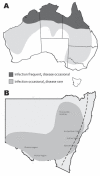The changing epidemiology of Kunjin virus in Australia
- PMID: 24287851
- PMCID: PMC3881112
- DOI: 10.3390/ijerph10126255
The changing epidemiology of Kunjin virus in Australia
Abstract
West Nile virus (WNV) is a mosquito-borne virus responsible for outbreaks of viral encephalitis in humans and horses, with particularly virulent strains causing recent outbreaks of disease in Eastern Europe, the Middle East and North America. A strain of WNV, Kunjin (WNVKUN), is endemic in northern Australia and infection with this virus is generally asymptomatic. However in early 2011, an unprecedented outbreak of encephalitis in horses occurred in south-eastern Australia, resulting in mortality in approximately 10%-15% of infected horses. A WNV-like virus (WNVNSW2011) was isolated and found to be most closely related to the indigenous WNVKUN, rather than other exotic WNV strains. Furthermore, at least two amino acid changes associated with increased virulence of the North American New York 99 strain (WNVNY99) compared to the prototype WNVKUN were present in the WNVNSW2011 sequence. This review summarizes our current understanding of WNVKUN and how the epidemiology and ecology of this virus has changed. Analysis of virulence determinants of contemporary WNVKUN isolates will provide clues on where virulent strains have emerged in Australia. A better understanding of the changing ecology and epidemiology associated with the emergence of virulent strains is essential to prepare for future outbreaks of WNV disease in Australia.
Figures



Similar articles
-
Virulence and Evolution of West Nile Virus, Australia, 1960-2012.Emerg Infect Dis. 2016 Aug;22(8):1353-62. doi: 10.3201/eid2208.151719. Emerg Infect Dis. 2016. PMID: 27433830 Free PMC article.
-
The human and animal health impacts of introduction and spread of an exotic strain of West Nile virus in Australia.Prev Vet Med. 2013 May 1;109(3-4):186-204. doi: 10.1016/j.prevetmed.2012.09.018. Epub 2012 Oct 23. Prev Vet Med. 2013. PMID: 23098914
-
Systematic analysis of viral genes responsible for differential virulence between American and Australian West Nile virus strains.J Gen Virol. 2015 Jun;96(Pt 6):1297-1308. doi: 10.1099/vir.0.000069. Epub 2015 Jan 27. J Gen Virol. 2015. PMID: 25626681
-
The role of Australian mosquito species in the transmission of endemic and exotic West Nile virus strains.Int J Environ Res Public Health. 2013 Aug 19;10(8):3735-52. doi: 10.3390/ijerph10083735. Int J Environ Res Public Health. 2013. PMID: 23965926 Free PMC article. Review.
-
Transmission dynamics and changing epidemiology of West Nile virus.Anim Health Res Rev. 2008 Jun;9(1):71-86. doi: 10.1017/S1466252307001430. Epub 2008 Mar 19. Anim Health Res Rev. 2008. PMID: 18348742 Review.
Cited by
-
The Australian Public is Still Vulnerable to Emerging Virulent Strains of West Nile Virus.Front Public Health. 2014 Sep 17;2:146. doi: 10.3389/fpubh.2014.00146. eCollection 2014. Front Public Health. 2014. PMID: 25279370 Free PMC article.
-
Lessons Learned from West Nile Virus Infection:Vaccinations in Equines and Their Implications for One Health Approaches.Viruses. 2024 May 14;16(5):781. doi: 10.3390/v16050781. Viruses. 2024. PMID: 38793662 Free PMC article. Review.
-
Evolution of Zika virus in Rag1-deficient mice selects for unique envelope glycosylation motif mutants that show enhanced replication fitness.Virus Evol. 2025 Apr 11;11(1):veaf021. doi: 10.1093/ve/veaf021. eCollection 2025. Virus Evol. 2025. PMID: 40291117 Free PMC article.
-
European College of Equine Internal Medicine consensus statement on equine flaviviridae infections in Europe.J Vet Intern Med. 2022 Nov;36(6):1858-1871. doi: 10.1111/jvim.16581. Epub 2022 Nov 11. J Vet Intern Med. 2022. PMID: 36367340 Free PMC article.
-
Nucleic Acid Preservation Card Surveillance Is Effective for Monitoring Arbovirus Transmission on Crocodile Farms and Provides a One Health Benefit to Northern Australia.Viruses. 2022 Jun 20;14(6):1342. doi: 10.3390/v14061342. Viruses. 2022. PMID: 35746812 Free PMC article.
References
-
- Lanciotti R.S., Roehrig J.T., Deubel V., Smith J., Parker M., Steele K., Crise B., Volpe K.E., Crabtree M.B., Scherret J.H., et al. Origin of the West Nile virus responsible for an outbreak of encephalitis in the northeastern United States. Science. 1999;286:2333–2337. doi: 10.1126/science.286.5448.2333. - DOI - PubMed
Publication types
MeSH terms
LinkOut - more resources
Full Text Sources
Other Literature Sources
Medical

